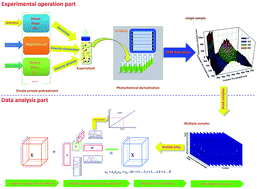Interference-free analysis of aflatoxin B1 and G1 in various foodstuffs using trilinear component modeling of excitation–emission matrix fluorescence data enhanced through photochemical derivatization†
Abstract
A novel ‘dilute-and-shoot’ analytical strategy coupling a self-weighted alternating normalized residue fitting (SWANRF) algorithm with two-dimensional fluorescence detection enhanced through photochemical derivatization (PD) was proposed in the present work for rapid, simultaneous and accurate quantitative analysis of aflatoxin B1 and G1 in various foodstuffs (including cereals, honey, and edible oil). By coupling the predominant second-order advantage of the SWANRF algorithm with the ultra-sensitivity of fluorescence detection enhanced through off-line photochemical derivatization, the specific quantitative information of both analytes could be successfully extracted from heavily interferential matrices without complicated multi-step purification and chromatographic separation procedures. Consequently, the whole analytical time and expense were significantly decreased, accurate recoveries (with relative standard deviations, RSDs) (93.5 ± 6.6–102.8 ± 4.0% for AFB1, and 96.4 ± 3.6–107.2 ± 6.0% for AFG1) and extremely low limits of detection (LODs) (0.12–0.21 ng mL−1 for AFB1, and 0.27–0.75 ng mL−1 for AFG1) were obtained for analytical foodstuff matrices. In addition, all quantitative results of this proposed strategy were carefully compared with the standard IAC-LC-ESI+-MS method for further confirmation, which proved that SWANRF-EEMs are promising as an alternative analytical strategy for the routine analysis of multiplex aflatoxins, and a theoretical basis for developing portable detecting devices.


 Please wait while we load your content...
Please wait while we load your content...